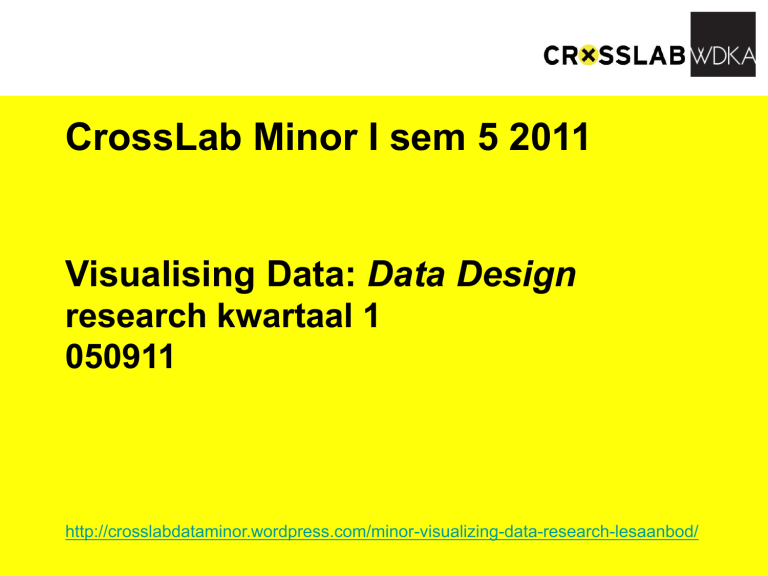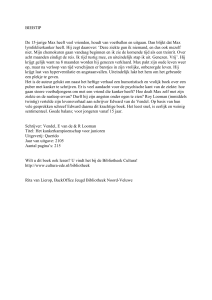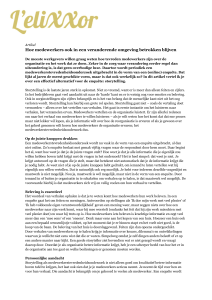
CrossLab Minor I sem 5 2011
Visualising Data: Data Design
research kwartaal 1
050911
http://crosslabdataminor.wordpress.com/minor-visualizing-data-research-lesaanbod/
thema 1: data storytelling
data as ‘beautiful evidence’ /
‘storytelling’
Datavisualisatie:
quantificatie & kwalificatie van informatie
Science and art have in common intense seeing,
the wide-eyed observing that generates empirical information.
This book is about how that seeing turns into showing.
Edward Tufte, Beautiful Evidence, 2006
oudste kaart ?: Catal Huyuk 6200 BC
oudste kaart: Catal Huyuk 6200 BC
Lust, 2006, http://lust.nl/oog/oog.php?view=world
centrale vragen:
> wat is de relatie vormgeving en inhoud?
(context / doel, ontwerpprincipes, ‘datafilters’)
> datavisualisatie: bewijs / verhaal?
‘beautiful evidence’ (Tufte) of: storytelling / ‘awareness’
> wat kenmerkt het auteurschap (handschrift) in een
datavisualisatie?
--> eindopdracht = statement datavisualisatie
research blok 1:
vooronderzoek: achtergrond, definities, voorb,, actueel debat
stap 1: wat is datavisualisatie
definities / context: kenmerken, voorgeschiedenis, actualiteit
deskresearch:
onderzoek naar bestaande gegevens
> voorbeeldprojecten
stap 2: wat zijn criteria voor datavisualisatie? data storytelling
definities / context: design principles, datajournalism
fieldresearch:
verzamelen nieuwe gegevens
> dataset opdracht praktijk
stap 3: wat is het actuele debat?
context:
opinies, discussies, vraagstukken
(selftracking, Open Data etc.)
deskresearch:
inventarisatie vakliteratuur / actuele media
research blok 1:
vooronderzoek: achtergrond, definities, voorb., actueel debat
stap 4: wat is de rol van de ontwerper?
welke ontwerpprincipes bestaan er voor datavisualisatie?
deskresearch: vakbronnen
stap 5 : formuleren eerste statement t.o.v. dataviz.
(onderbouwen, motiveren, literatuur)
stap 6 : definiëren onderzoeksvraag voor blok 2
(onderzoek verdiepen)
opdracht kwartaal 1
> statement [1500 w] met ontwerpprincipes voor de
praktijkopdracht. Reflecteer op:
- datavisualisatie en storytelling
- transparancy / ‘data as beautiful evidence’,
- open data / participerende interfaces,
- gebruik van metaforen
> een onderzoeksvraag voor blok 2
> literatuurlijst (minimaal 8 bronnen).
thema 1: Data storytelling
> zijn data datavisualisaties altijd neutraal en objectief?
(manipulatieve waarde)
> de ontwerper als ‘data storyteller’
> welke uitgangspunten en ‘datafilters’?
Obama, Tufte & datavisualisatie
research opdracht 1
uitgangspunten voor informatievisualisatie [blog]
> lezen: David Case, How to Design with Numbers (kopie)
- vat de kerngedachte samen
- welke criteria definieert Case voor informatievisualisatie?
- welke discussies / standpunten zijn er?
(maak aantekeningen> blog)
- analyse >
http://www.flickr.com/photos/laurenmanning/sets/72157626586750924/
uitgangspunten
data design
simplicity?
A visual display of data should be simple enough
to fit on the side of a van
Edward Tufte, the Feynman-Tufte principle, Scientifc American, mrt 2005
What's the best way for the information graphic
to tell the story?
Sure, sometimes it is with a realistic view.
But to my mind, in this business of information design,
more often simpler is better.
Nigel Holmes, Why function always trumps format, 2004
Nigel Holmes: http://www.nigelholmes.com/
uitgangspunten
data als bewijs:
transparancy?
Beautiful Evidence, Edward Tufte, 2006
http://www.edwardtufte.com
http://www.edwardtufte.com/bboard/q-and-a-fetch-msg?msg_id=0002vW
Visual representations of evidence should be governed by
principles of reasoning about quantitative evidence.
Clear and precise seeing becomes as one with clear and
precise thinking.
Edward Tufte, design principles
http://awesome.good.is/transparency/web/1105/osama-bin-laden/flat.html
Chartjunk kan turn bores into disasters, but it can
never rescue a thin data set.
The best designs are intriguing and curiosity-provoking,
drawing the viewer into the wonder of the data,
sometimes by narrative power, sometimes by immense
detail, and sometimes by elegant presentation of simple
but interesting data.
But no information, no sense of discovery, no wonder,
no substance is generated by chartjunk
Edward Tufte, Beautiful Evidence
Chartjunk / infoporn ?
blog.tommorris.org/post/2956998165/infographics-are-porn-without-the-happy-ending
uitgangspunten
data als storytelling
correlations?
Hans Rosling, The Joy of Stats
http://www.gapminder.org/
correlations / story?
http://www.xach.com/moviecharts/2009.html
correlations / story?
http://moebio.com/plasma/
data als storytelling:
datajournalism
datajournalistiek:
storytelling en datavisualisatie in de praktijk
http://datajournalism.stanford.edu/
http://www.guardian.co.uk/data
http://www.denieuwereporter.nl/2010/01/informatievisualisatie-alsopkomend-journalistiek-genre/
samengevat
Datastorytelling: ‘beautiful evidence’ I bewijsmateriaal?
enkele uitgangspunten:
- data design: simplicity? (Holmes, Tufte)
- data as evidence: transparency? (Tufte)
- data as story: correlations? (Rosling)
opdracht 120911:
> lezen:
Edward Tufte, The fundamental principles of
Analytical Design (kopie)
kern samenvatten
> selecteer 3 datavisualisaties.
Analyseer: hoe worden de principes van Case,
Holmes, Rosling en Tufte hierbij ingezet?
> publiceren op blog










